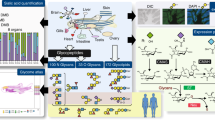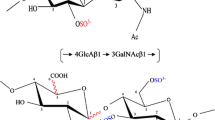Abstract
As a first step to elucidate a role of N-glycans in development of vertebrates, we analyzed structures of the glycans expressed in early stages of zebrafish embryo. N-glycans were prepared from zebrafish embryos at several developmental stages followed by tagging with a fluorophore, 2-aminopyridine. The labeled glycans were analyzed by two modes of HPLC’s. The comparison of the elution profiles of HPLC’s unveil the change of the oligosaccharide structure during the development. These peaks were merely detected during 4–7 h after fertilization, however, increased from 12 h, and at 15 h a fairly amount of them was appeared. Structure analysis revealed that they were bianntenary complex-type N-glycans with or without fucose and/or bisecting N-acetylglucosamine residues. These results suggest that the complex-type N-glycans are concerned in some developmental event from segmentation period downward in zebrafish. Published in 2005.
Similar content being viewed by others
References
Wacker M, Linton D, Hitchen PG, Nita-Lazar M, Haslam SM, North SJ, Panico M, Morris HR, Dell A, Wren BW, Aebi M, N-linked glycosylation in Campylobacter jejuni and its functional transfer into E. coli, Science 298, 1790–3 (2002).
Young NM, Brisson JR, Kelly J, Watson DC, Tessier L, Lanthier PH, Jarrell HC, Cadotte N, St Michael F, Aberg E, Szymanski CM, Structure of the N-linked glycan present on multiple glycoproteins in the Gram-negative bacterium, Campylobacter jejuni, J Biol Chem 277, 42530–9 (2002).
Helenius A, Aebi M, Intracellular functions of N-linked glycans, Science 291, 2364–9 (2001).
Gottlieb C, Baenziger J, Kornfeld S, Deficient uridine diphosphate-N-acetylglucosamine:glycoprotein N-acetylglucosaminyltransferase activity in a clone of Chinese hamster ovary cells with altered surface glycoproteins, J Biol Chem, 250, 3303–9 (1975).
Stanley P, Narasimhan S, Siminovitch L, Schachter H, Chinese hamster ovary cells selected for resistance to the cytotoxicity of phytohemagglutinin are deficient in a UDP-N-acetylglucosamine-glycoprotein N-acetylglucosaminyltransferase activity, Proc Natl Acad Sci USA 72, 3323–7 (1975).
Metzler M, Gertz A, Sarkar M, Schachter JW, Marth JD. (1994) Complex asparagine-linked oligosaccharides are required for morphogenic events during post-implantation development, EMBO J 13, 2056–65.
Ioffe E, Stanley P. Mice lacking N-acetylglucosaminyltransferase I activity die at mid-gestation, revealing an essential role for complex or hybrid N-linked carbohydrates. Proc Natl Acad Sci USA 91, 728–32 (1994).
Hase S, Ikenaka T, Matsushima Y, Structural analysis of oligosaccharides by tagging of the reducing end sugars with a fluorescent compound, Biochem Biophys Res Commun 85, 257–63 (1978).
Hase S, Ikenaka T, Matsushima Y. A highly sensitive method for analyses of oligosaccharides by tagging of the reducing end sugars with a fluorescent compound, J Biochem 9, 407–14 (1981).
Muramatsu T. Developmentally regulated expression of cell surface carbohydrates during mouse embryogenesis, J Cell Biochem 36, 1–14 (1988).
Streisinger G, The Zebrafish Book, edited by Westerfield M (University of Oregon Press, Eugene, OR, 1995).
Natsuka S, Hase S, Analysis of N- and O-glycans by pyridylamination, Methods Mol Biol 76, 101–13 (1998).
Yanagida K, Natsuka S, Hase S, A pyridylamination method aimed at automatic oligosaccharide Analysis of N-linked Sugar Chains, Anal Biochem 274, 229–34 (1999).
Yanagida K, Ogawa H, Omichi K, Hase S, Introduction of a new scale into reversed-phase high performance liquid chromatography of pyridylamino sugar chains for structural assignment, J Chromatogr A 800, 187–98 (1998).
Makino Y, Omichi K, Hase S, Analysis of sugar chain structures from the reducing end terminal by combining partial acid hydrolysis and a two-dimensional sugar map, Anal Biochem 263, 172–179, (1998).
Finne J, Finne U, Deagostini-Bazin H, Goridis C, Occurrence of α2-8 linked polysialosyl units in a neural cell adhesion molecule, Biochem Biophys Res Commun, 112, 482–7 (1983).
Schachner M, Martini R, Glycans and the modulation of neural-recognition molecule function, Trends Neurosci, 18, 183–91 (1995).
Author information
Authors and Affiliations
Corresponding author
Rights and permissions
About this article
Cite this article
Takemoto, T., Natsuka, S., Nakakita, Si. et al. Expression of complex-type N-glycans in developmental periods of zebrafish embryo. Glycoconj J 22, 21–26 (2005). https://doi.org/10.1007/s10719-005-0189-5
Received:
Revised:
Accepted:
Issue Date:
DOI: https://doi.org/10.1007/s10719-005-0189-5




